Fast, sleek and streamlined, these are some of the best express passenger steam locomotives ever built. This week’s Class Information features a popular class among steam enthusiasts, Sir Nigel Gresley’s A4 Class.
Once looking at their incredible service under both London and North Eastern Railway (LNER) and British Railways (BR) ownership, we will then see where and the conditions of the preserved members.
LNER A4 Class
The 1930s saw increased competition from both within the ‘Big Four’ railways and other modes of transport, Road and Air.
To remain competitive with rivals and increase passenger numbers, the LNER wanted to release faster train services. For this to be possible, a new class of engines was needed.
With the need for a new class, Gresley examined what other railways had been doing to achieve faster services. At the time, the German State Railways had recently introduced their “Flying Hamburger” service, a diesel-powered service of a two and three car set. This service had achieved speeds of 112mph, with usual operating speeds in the high 80s.
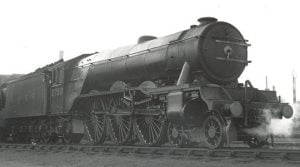
With this, Gresley put his A1 and A3 under trials when he returned home. During test runs A3 No.2750 “Papyrus” achieved a record-breaking 108mph, also A1 No.4472 “Flying Scotsman” had hit 100mph. With these fantastic runs by current express passenger engines, Gresley was given permission to build a new class of engines, which would become the A4s.
Design and Construction
The A3 class provided the basis for the new class. In order to produce more power, the internal steam circuit was streamlined further, boiler pressure upped to 250psi and the addition of a combustion chamber. To reduce air resistance, the externals of the locomotives were streamlined, with a wedge-shaped nose covering the smokebox and valances over the valve gearing and coupled wheels. Another benefit of the streamlining was the updraft created pushed steam and smoke from the chimney out of driver’s view, a problem suffered on the un-streamlined A1s and A3s.
Initially, four engines were built. These would exclusively haul the new “Silver Jubilee” service introduced for the A4s. Made up of seven streamlined coaches with a capacity of 198 people, the train took four hours to travel from London’s King’s Cross to Newcastle. The train was named after King George V’s Silver Jubilee. Early September 1935 saw No.2509 “Silver Link” completed at Doncaster Works, with trials taking place in late September, ahead of the first train of the Silver Jubilee. Whilst on trials, 2509 ran at 112mph twice, as well as sustaining 100mph for 43 miles.
The Silver Jubilee was a huge success for the LNER. This led to the service being extended to Edinburgh and the introduction of more services for the A4s to haul.
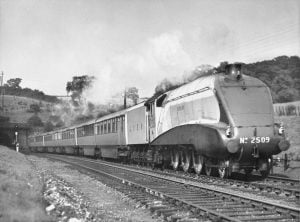
Performance in Service
For just over a month, No.2509 and No.2510 “Quicksilver” handled the service by themselves with little to no problems. This is also true in the longer term too, when after 1,952 Silver Jubilee trains, only 10 had an A4 suffer from a mechanical issue. The last member of the first four No.2512 “Silver Fox” in 1936 hit 113mph while pulling the Silver Jubilee. July 1937 saw the introduction of “The Coronation” train service and November 1937 the ” West Riding Limited” was added, a job usually allocated to the A4s.
Footplate crews liked the A4s, they gave a smooth ride, even at high speeds, and had plenty of power to handle heavy, long-distance trains. More and more A4s were outshopped between Late 1936 and Summer 1938, when the last engine No.4469 “Gadwall” was completed on August 30th, 1938.
In March 1938, the latest A4 at the time No.4468 “Mallard” was put into traffic. 4468 had received an improved over previous engines in that Mallard was fitted with a Kylchap double chimney and blastpipe. This allowed the engine to exhaust more steam and smoke out of the locomotive, improving performance at high speeds. With this and the senior management of the LNER knowing the capabilities of the A4s, a hand-picked crew were brought down to King’s Cross where 4468, paired with a dynamometer car and a train of six coaches, heading out to try and break the world steam speed record.
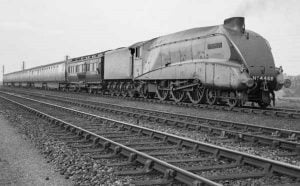
On the return trip to King’s Cross between Grantham and Peterborough, Mallard achieves a world record speed for steam of 126mph on Stoke Bank. Unfortunately, measures to prevent the overheating of the middle cylinder’s big end bearing failed, and the train with 4468 still attached was piloted by an Ivatt Atlantic from Peterborough back to King’s Cross. The planned second attempt at breaking the world steam speed record in September 1939 was cancelled due to the outbreak of World War 2.
Rail traffic increased during the war, with the A4s playing their part. They could be found on various heavy passenger trains, some with loads up to 750 tonnes. It is with these trains the A4’s power was put to the test and where No.4901 “Capercaillie” produced 2,200 drawbar horsepower at the head of a 730-ton train. With less time for maintenance as there was a bigger focus on the war effort, the valances covering the coupled wheels were removed to make lubrication easier.
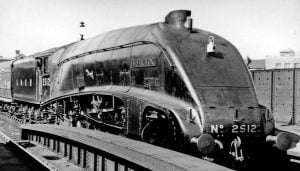
After the war was over, the A4s returned back to dominate the East Coast Mainline express passenger trains, despite the introduction of newer pacifics of Thompson and Peppercorn. Following the superior performance and reduced coal consumption from the Kylchap fitted A4s, the reluctant senior management approved fitting the equipment to the whole class when cost benefits were realised.
Issues in Service
One of the biggest issues to affect the whole class was the overheating of the middle cylinder’s big end bearing. Notable occasions where this happened are the Mallard’s world speed record run and three times during the 1948 Exchange Trials, resulting in swapping the A4 taking part a couple of times. The problem was caused by Gresley’s Conjugated gearing, which at high speeds caused the middle cylinder to work harder than the outside cylinders. The strain on this cylinder would eventually cause it to overheat and the bearing to melt. This resulted in the engine being withdrawn from traffic while repair work was carried out.
A solution for the problem was finally implemented in the early 1950s when R. J. Cook became Mechanical and Electrical Engineer for the Eastern Region of BR. Originally from the Great Western Railway / Western Region, he brought over some practices on his move. Notably, he used the GWR type of bearing combined with tighter tolerances when reassembling the A4s. These two new methods were successful, with the big end issue resolved, as long as regular inspections were carried out.
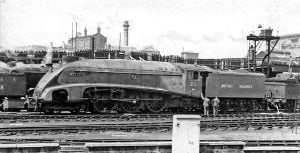
Liveries
No.2509 to 2512 were first outshopped in a Silver and Grey livery, to match the Silver Jubilee stock. With more A4s being built for use on other services, the fifth member of the class No.4482 “Golden Eagle” was painted in LNER Lined Apple Green, worn by A1s and A3s. However, this was short lived as from May 1937 the standard livery for the class became Garter Blue, which was carried by 4468 “Mallard” just over a year later when achieving 126mph.
Wartime brought the need for painting engines in Black to reduce visibility from enemy bombers. Post-war pre-BR years saw the return of Garter Blue. The newly-formed BR experimented with liveries they could apply to all express passenger engines. This led to Express Blue being introduced on the A4s. Like Apple Green, this lasted only a couple of years before being replaced by BR Lined Green, being carried by the class to the end of their BR lives.
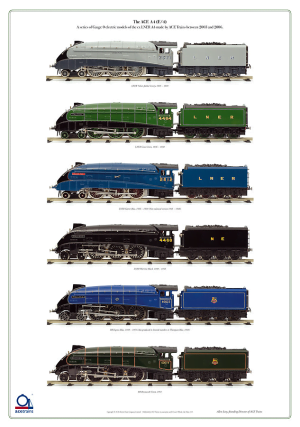
Decline and Withdrawal
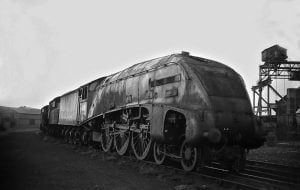
World War 2 impacted the railways, with the A4 class losing one member, No.4469 “Gadwall” when a bomb fell only meters away from it. The poor state of the engine meant it would have been uneconomical to repair and no replacement engine was ordered. The A4s remained on the top link work throughout the 1950s and early 1960s until the diesel Class 55 “Deltics” were allocated to express trains out of King’s Cross. This began the withdrawal of the class, starting in the southern parts of the Eastern Region first, before heading northwards. Some members move shed up North to Scotland where steam was still in heavy use but others, like No.60014 (2509) “Silver Link” were removed from traffic from December 1962 onwards. Six engines survived in Scotland until 1966, when No.60019 (4464) “Bittern” was the last member in the class to be withdrawn from service after 29 years.
Preservation
Six engines of the class were saved from the cutter’s touch. For a class of 35 engines, six is an impressive number, especially when only one LNER engine ended up in Barry Scrapyard.
-
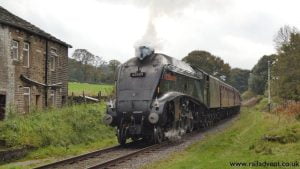
60009 at Townsend Fold 60009 (4488) “Union of South Africa” – Operational on the mainline, due to be withdrawn from traffic in June 2019. Currently in BR Lined Green with Late Crest livery. Originally named “Osprey”, 4488’s named was changed to recognise a member of the Commonwealth countries. Shortly after being withdrawn, 60009 was purchased by John Cameron and moved to the Lochty Private Railway. The next few decades saw “Union of South Africa” move between a few former goods sheds in Scotland while working a small number of mainline tours. During its persevered mainline career 60009 has worked across the whole of the UK, from its home in BR days of Scotland to Plymouth in the South West. Amongst mainline work, “Union of South Africa” has visited a number heritage lines, such as North Yorkshire Moors Railway and Nene Valley Railway. In early 2017 it was announced that when 60009’s boiler ticket expires in June 2019, the engine would be retired permanently and displayed in a purpose-built museum in Scotland. With this news, the A4 has been a very popular engine with enthusiasts wherever 60009 has visited.
- 4489 (60010) “Dominion of Canada” – Static display in Canada. Like 4488, “Dominion of Canada” was firstly named after a bird, “Woodcock”. At first, 4489’s fate looked uncertain in preservation. On withdrawal, the locomotive was stored at the back of Darlington MPD, forgotten and left with weeds to grow up around the engine. When the MPD closed a year later, “Dominion of Canada” was taken to Crewe where full cosmetic restoration was performed back to BR Green. On completion, the engine was donated to the Canadian Railroad Historical Association and moved to Canadian Railway Museum near Montreal. After over 4 decades in Canada, the National Railway Museum organised for 60010 to be brought back to England, where cosmetic repairs would be undertaken (Liveried as 4489 in Garter Blue with stainless chrome trim) and displayed with the other five remaining A4s to celebrate the 75th anniversary of Mallard’s world speed record. Being restored back to 4489 guise, its CPR bell and 5-chime whistle were refitted after being removed back in BR days when the double chimney was installed. Spring 2014 saw 4489 return back to Canada where the engine is back on display.
- 60008 (4496) “Dwight D. Eisenhower” – Static display in America. Originally named “Golden Shuttle”, the engine was named after Dwight D. Eisenhower in 1945. Unlike 4489, 60008 was cosmetically restored shortly after withdrawal in July 1963 and donated to National Railroad Museum, Green Bay, Wisconsin. Carrying its BR number 60008 and BR Green, “Dwight D. Eisenhower” was shipped to its new home in America. 49 years later, 60008 was brought back to England to celebrate the 75th anniversary of Mallard’s world speed record. Restored back to the correct Brunswick Green, after the wrong colour was applied while in the US, 60008 was put on display with the other surviving A4s. Following its two year stay in the UK, “Dwight D. Eisenhower” returned home in 2014.
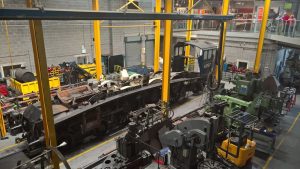 60007 (4498) “Sir Nigel Gresley” – Undergoing an overhaul at NRM York. As the 100th 4-6-2 ‘Pacific’ to built to a Sir Nigel Gresley design, officials at the LNER felt it was appropriate to name 4498 after him. This is one of the main reason for the engine being saved for preservation. Once restored at Crewe works to 4498 in Garter Blue (without valances), “Sir Nigel Gresley” moved to Steamtown at Carnforth, where several other persevered steam engines were based. From here, 4498 worked various mainline tours across the country. Mid 1996 saw the locomotive move to the North Yorkshire Moors Railway, where the engine is based when not working mainline tours. Last boiler ticket expired in September 2015.
60007 (4498) “Sir Nigel Gresley” – Undergoing an overhaul at NRM York. As the 100th 4-6-2 ‘Pacific’ to built to a Sir Nigel Gresley design, officials at the LNER felt it was appropriate to name 4498 after him. This is one of the main reason for the engine being saved for preservation. Once restored at Crewe works to 4498 in Garter Blue (without valances), “Sir Nigel Gresley” moved to Steamtown at Carnforth, where several other persevered steam engines were based. From here, 4498 worked various mainline tours across the country. Mid 1996 saw the locomotive move to the North Yorkshire Moors Railway, where the engine is based when not working mainline tours. Last boiler ticket expired in September 2015.- 4464 (60019) “Bittern” – On display while awaiting overhaul. At first, preservation went well, after being purchased by Geoff Drury, “Bittern” hauled a number of mainline tours before the discovery of frame cracks and a few other issues. At the time, the cracks were deemed beyond repair and this ended 4464’s working career for the foreseeable future. Following a move to Dinting Railway Centre with 60532 “Blue Peter”, both engines saw little use. The North Eastern Locomotive Preservation Group (NELPG) agreed to take care of both engines in 1987, and while 60532 was overhauled to full working order, “Bittern” with its major faults was only cosmetically restored as lost and first-class member 2509 “Silver Link” in the striking Silver and Grey livery. 4464 stayed in this guise until 1995 when a start on restoring the engine was made at the Great Central Railway. Two years later after only a small amount of dismantling work, the current owner of the “Flying Scotsman” Tony Marchington brought “Bittern”. This was short-lived and 4464 changed ownership in 2001, with new owner Jeremy Hosking moving the A4 to the Mid Hants Railway for restoration. By the end of 2007, “Bittern” had returned to full working order, including for mainline operation. For the next eight years “Bittern” worked numerous mainline and heritage trains in a few different liveries, including as lost class member 4492 “Dominion of New Zealand” working with two tenders. Late 2015 saw 4464 haul its final train on its boiler ticket. Operated by Icons of Steam, “Bittern” now waits for its turn in the overhaul whilst engines such as 60532 “Blue Peter” and 5029 “Nunney Castle” undergo overhaul and repairs.
-
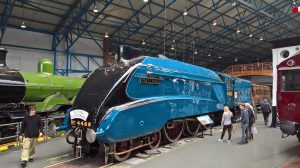
Credit: RailAdvent 4468 (60022) “Mallard” – It comes with little surprise that the world’s fastest steam locomotive was saved for preservation. When withdrawn in 1963, “Mallard” was restored back to Garter Blue livery, which it wore when achieving 126mph. Joining the National Collection is 1975, 4468 has been one of the most popular displays at the National Railway Museum York. To celebrate 50 years since its record run, “Mallard” was restored to mainline standard for running between 1986 to 1988, where it hauled many mainline tours. On expiry of its two-year running period, 4468 went back to being a static display, which it has been from 1988 to present. 2013 marked the 75th anniversary of the world speed record, and for this, the NRM brought all six surviving A4s together, including 60008 and 60010 in North America. Due to the engine’s condition, its unlikely to be overhauled in the foreseeable future.
We hope you have enjoyed this week’s Class Information on the legendary A4s. Next week brings us to an LMS Sole Survivor, can you guess which class we will be covering? Here’s the last LMS Sole Survivor we produced, on the Ivatt Class 4 No.43106.
Where Next?
News Homepage
For the Latest Railway News
RailAdvent Online Shop
Framed Prints, DVD’s / Blu-Ray’s and more
LocoStop – The RailAdvent Community
Come and share your railway pictures


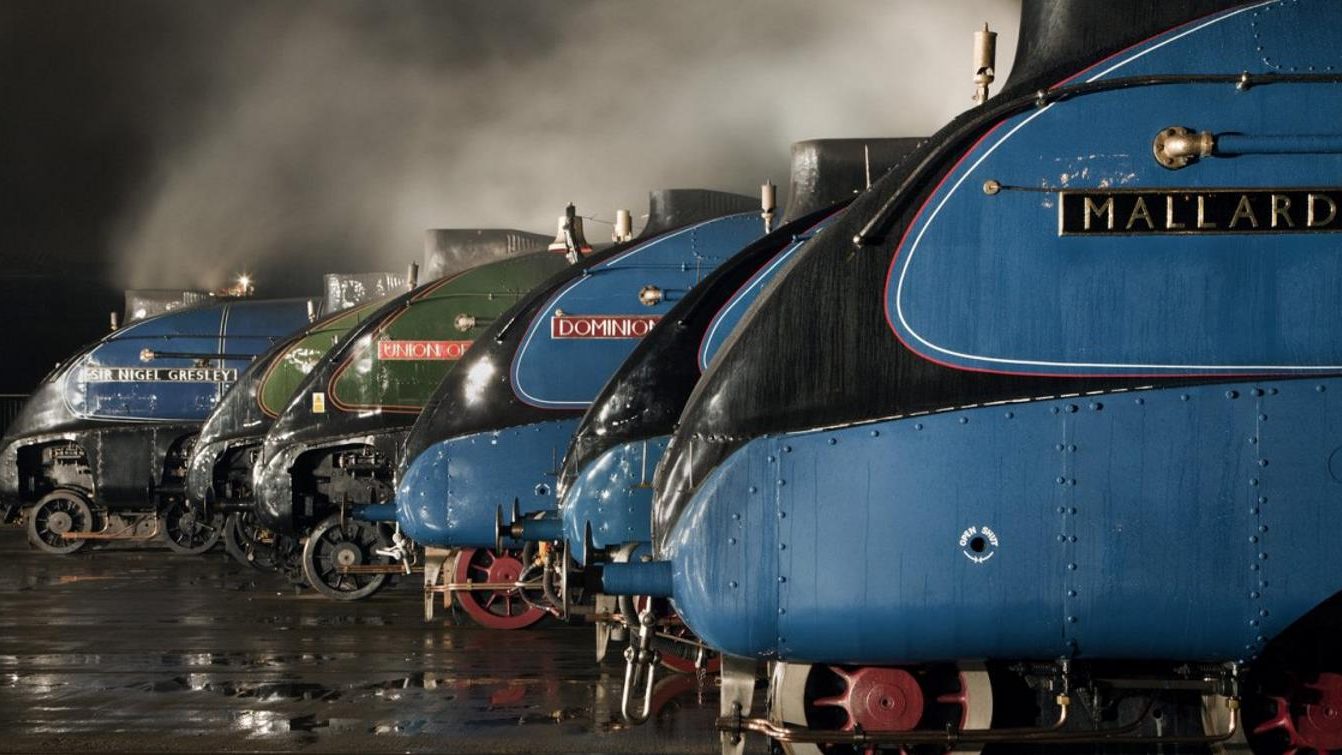

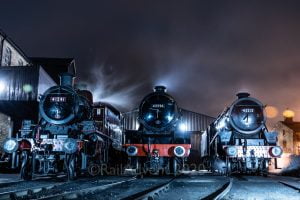

Responses
could we have domain of New Zealand back in the uk and domain of Canada so that they can stay in the uk forever
i would build 600 a4 trains
would it be cool
i will be the future builder for a4 trains
I wonder if someone can explain the following ‘anomaly’.
It has been stated that the A4 ‘WOODCOCK’ was renamed ‘DOMINION OF CANADA’. Yet in my Ian Allan ABC combined volume of Summer 1958, BOTH locomotives are listed; WOODCOCK as BR number 60029, and DOMINION OF CANADA as 60010. Moreover, as a 10/11yr old, I still have my ABC of A4 pacifics underlined as being ‘copped’ pulling the ELIZABETHAN as it passed through Wood Green station in either 1958 or ’59.
Any explanation for that?
The locomotive was built at Doncaster works in May 1937 as Works Number 1854. It was originally to be named Buzzard but initially received the name Woodcock instead until it was renamed Dominion of Canada by High Commissioner of Canada, H. Vincent Massey on 15 June 1937. It was after this that 60029 was given the name WOODCOCK.
my loco spotters book summer 1959 says there are 34 A4s , Would there have been 35 if one was not destroyed by a bomb WW2 ?
[…] We hope you have enjoyed this week’s Sole Survivor. Next week will see the next instalment of the Lost Class series be released, on a Southern Railway class. Missed last week’s Class Information? Don’t worry, as you can read it here. […]
“also A1 No.4472 “Flying Scotsman” had hit 100mph.”. Needs changing to A3…
Hi Dave,
As far as I am aware No.4472 “Flying Scotsman” was rebuilt to an A3 in 1947. The run where 4472 achieved 100mph referred to in the article took place in 1934, when 4472 was an A1.
Therefore, the information is correct.
Regards,
Jamie
Issues in service.
Line 6 might read better if you wrote strain instead of stain.
Do your articles pass proof reading standards?
Hi Alistair,
Thank you for your comment and for spotting the small mistake. I have now updated this small error
We do proofread all of our articles before they are published, but when an article, like this one, has over 2,500 words – there is potential for one small mistake to be made.
Regards,
Michael